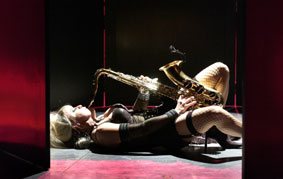


The Busker's Opera © Érick Labbé
busker (plural buskers), noun, U.K. street musician or entertainer: somebody who entertains in the street or a public place in the hope of receiving money from passers-by
The Beggar’s Opera was first performed in London on January 29, 1728, and it took the city by storm, becoming an overnight sensation. At once a satire of government corruption and a parody of then fashionable Italian opera, John Gay’s comic play with songs touched a deep chord in his audience. The characters were drawn from the hierarchy of the criminal underworld: highway robbers, cutthroats, fencers, jailors and prostitutes; and Gay’s new lyrics were set to existing melodies taken from popular songs of the day. For nearly 300 years, The Beggar’s Opera has enjoyed enduring success with its public, and it has inspired many adaptations and interpretations, perhaps most notably, The Three Penny Opera, written by Bertolt Brecht with music by Kurt Weill. It’s no wonder, then, that its characters have become such an important part of our modern theatre mythology.
Freely adapted from John Gay’s 18th century masterpiece, The Busker’s Opera is a new musical work for the theatre – or perhaps it is more aptly called a songspiel, as the Germans would say, since its story is told almost entirely in song. The show is currently being created at Ex Machina in Quebec City by director Robert Lepage and a group of 10 performing artists comprised of actors, musicians, singers and a DJ. Together, they have composed more than 30 new songs as well as reinvented Gay’s classic story for today’s audience. Fans of the original will recognize the characters of Macheath and his jealous lovers, Polly and Lucy; the prostitute, Jenny; as well as the ruthless Mr. and Mrs. Peachum and the corrupt Mr. Lockit. In The Busker’s Opera, however, the characters do not belong to the criminal underworld, but rather to the underworld of the music industry, counting among themselves musicians and aspiring celebrities, groupies, agents and entertainment lawyers, foundation representatives… and prostitutes (yes, some professions are timeless).
Like its source, The Busker’s Opera begins in London, but the show quickly changes gears and embarks on a Trans-Atlantic journey, first landing in New York and then traveling south through Atlantic City and New Orleans before arriving at its final destination, Huntsville, Texas. (Huntsville, by the way, is home to one of the principal capital punishment centers in the U.S., not to mention the infamous Killer Burger, which is served only on days when the death penalty is imposed) Throughout this satirical and often playful journey, many musical styles are explored: Ska, Reggae, Jazz, the Broadway/West End Show Tune, Rock, the Blues, Country, Tango, Disco, Rap and more. Irreverent and eclectic, the show also includes some of the classical melodies arranged by Dr. John Christopher Pepusch for the 1728 production of The Beggar’s Opera.
Somewhere between road trip and rock show, classical concert and the zydeco of the bayou, between the street musician and the sharks who seek to hold the keys to power, fame and fortune, The Busker’s Opera concerns itself with the artistic freedom that remains after the steamroller of the music industry has driven by.
The Busker's Opera
Inspired from The Beggar's Opera by John Gay
Original design & direction: Robert Lepage
Musical direction: Martin Bélanger
Assisted by: Steve Normandin
Dramaturg: Kevin McCoy
Music composed, arranged and performed by Frédérike Bédard, Martin Bélanger, Julie Fainer, Claire Gignac, Frédéric Lebrasseur ,Véronika Makdissi-Warren, Kevin McCoy, Steve Normandin, Marco Poulin, Jean René
Contribution to the musical arrangements: Jacques Leblanc
Text: John Gay
Adaptation: Kevin McCoy, Robert Lepage
Assistant to the director and stage manager: Félix Dagenais
Assistant set designer: Marco Poulin, Véronique Dumont, Paul Bourque
Assistant lighting designer: Laurent Routhier
Costume designer: Yasmina Giguère
Assisted by Isabel Poulin
Seamstresses: Janie Gagnon, Louise Guay, Sophie Royer
Wigs Rachel Tremblay
Production: Ex Machina
Co-production: Festival Montréal en Lumière ; La Filature, Scène nationale de Mulhouse ; Maison des Arts, Créteil ; Robert and Margrit Mondavi Center for Performing Arts, UC Davis ; Spielzeiteuropa I Berliner Festspiele, Berlin ; Théâtre de Caen ; Théâtre Royal de la Monnaie, Bruxelles ; Cankarjev Dom, Ljubljana ; Melbourne International Arts Festival, Melbourne ; Teatro Central, Sevilla
Producer for Ex Machina: Michel Bernatchez
Associate Production - Europe and Japan: Richard Castelli - Epidemic
Associate Production - The Americas, Asia (except Japan), Australia, NZ: Menno Plukker Theatre Agent
Ex Machina is funded by the Canada Council for the Arts, Quebec's Arts and Literature Council
and the City of Quebec.
